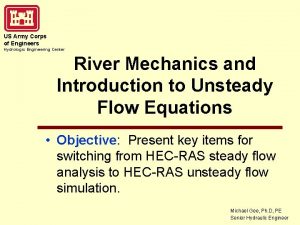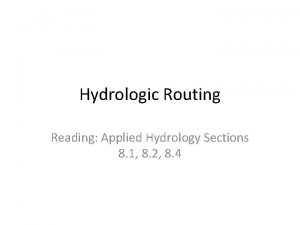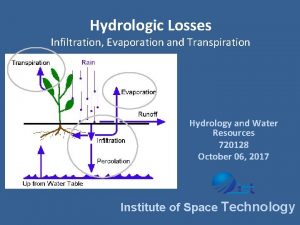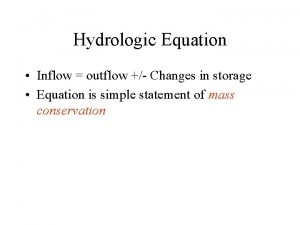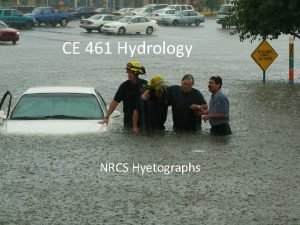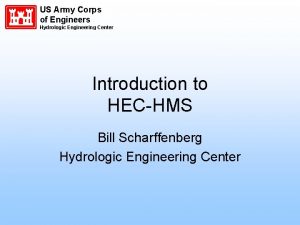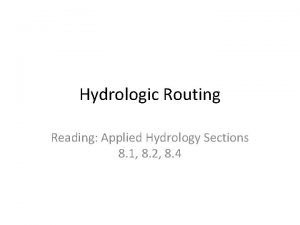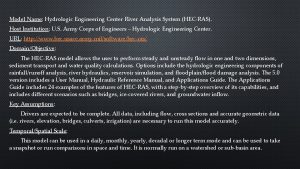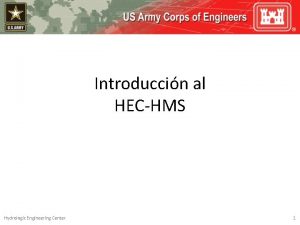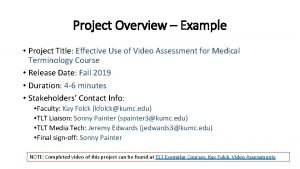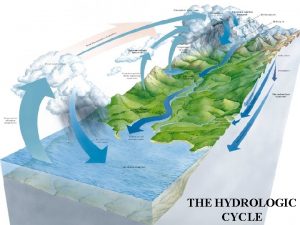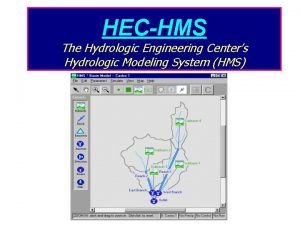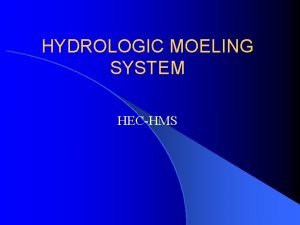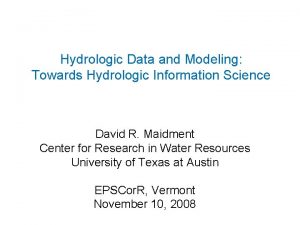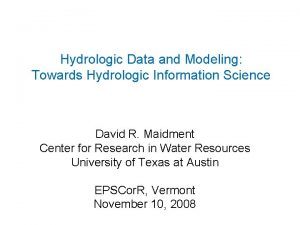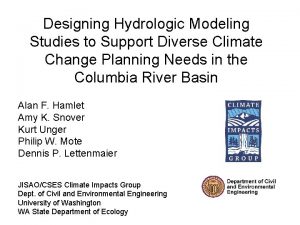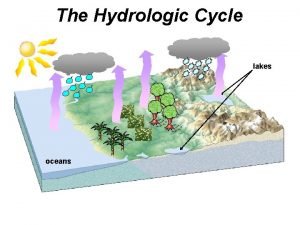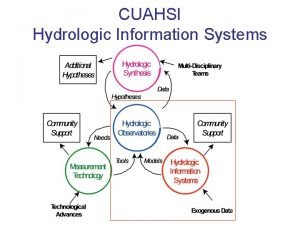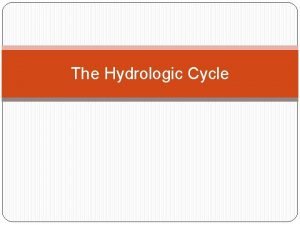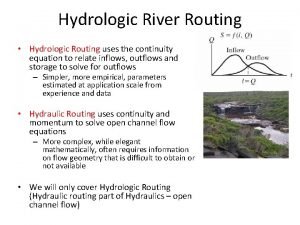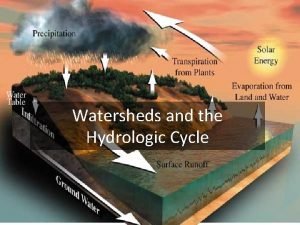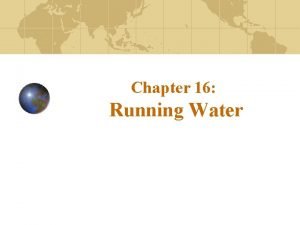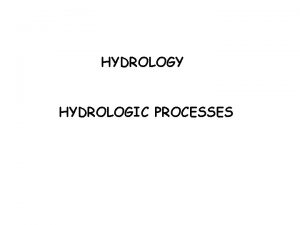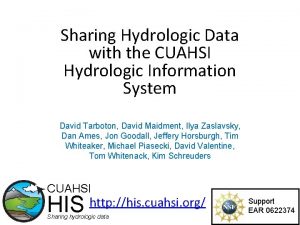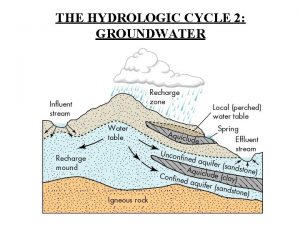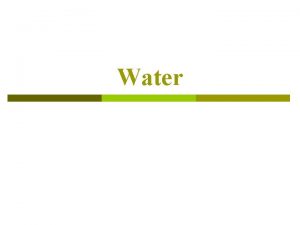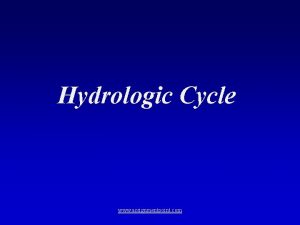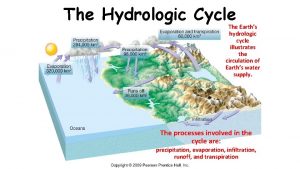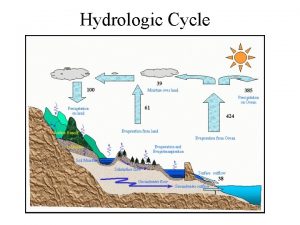Overview of Hydrologic Modeling for Project Studies Hydrologic



























- Slides: 27

Overview of Hydrologic Modeling for Project Studies Hydrologic Engineering Center 1

Objectives • • Describe the role of hydrologic modeling in USACE studies Describe types of studies where watershed modeling is generally applied Describe typical analysis procedures involving watershed modeling Introduce the Punxsutawney Watershed Hydrologic Engineering Center 2

Runoff Process – Hydrologic Cycle Hydrologic Engineering Center 3

Runoff Process Hydrologic Engineering Center 4

USACE Studies Requiring Watershed Modeling • • Flood Risk Management Feasibility Studies Floodplain Management Environmental Restoration Flood Forecasting Hydrologic Hazard Curve Development for Dam and Levee Safety Development of Probable Maximum Flood or Inflow Design Flood for Dam Safety Determination of Pump Station / Interior Drainage Adequacy for Levee Safety Reservoir Storage Reallocation or Water Control Manual Updates Hydrologic Engineering Center 5

Typical Flood Risk Management Feasibility Study Requirements Evaluate the cost effectiveness of proposed alternatives regarding the reduction of flood damage magnitude, duration, and/or frequency Hydrologic Engineering Center 6

Flow 1 Exceedance probability 0 Damage Stage 1 Exceedance probability 0

Typical Flood Risk Management Feasibility Study Procedures When hydrologic modeling is NOT required to fill in data gaps… • • • Define study objectives & information needs Obtain available streamflow, GIS, etc data Develop discharge- and stage-frequency curves for gaged locations Assist economist in developing Without Project stage-damage and damage-frequency curves Apply With Project conditions Determine EAD and BCR for all alternatives Hydrologic Engineering Center 8

Develop Flow-Frequency Curves Hydrologic Engineering Center 9

Develop Flow-Frequency Curves Hydrologic Engineering Center 10

Develop Flow-Frequency Curves Bulletin 17 C Procedures Hydrologic Engineering Center 11

Utilize Regional Information Hydrologic Engineering Center 12

Typical Flood Risk Management Feasibility Study Procedures When hydrologic modeling IS required to fill in data gaps… • Define modeling domain – • Choose modeling approaches – • • Initial and Constant or Green-Ampt losses? Discretize modeling domain – • Entire contributing drainage area or smaller area? Create elements (subbasins, routing reaches, etc) Parameterize elements using chosen modeling approaches Assemble hydrologic model Hydrologic Engineering Center 13

Typical Flood Risk Management Feasibility Study Procedures (continued) • • Calibrate the model using at least two events with observed data Validate the model using at least one independent event with observed data Develop Without Project conditions Develop hypothetical frequency-based storms and apply to determine flow-frequency at desired locations for Without Project conditions Develop With Project conditions Apply hypothetical storms to determine flow-frequency at desired locations for With Project conditions Assist in the determination of stage-frequency for all alternatives Assist economist in the determination of EAD and BCR for all alternatives Hydrologic Engineering Center 14

Develop Model Parameters Elevations Example Unit Hydrograph Transform Regression Equations Hydrologic Engineering Center Land Uses Soil Types Example Deficit and Constant Loss Parameters 15

Calibrate Model Parameters Hydrologic Engineering Center 16

Calibrate Model Parameters What is wrong with the model output? Is this model adequate to develop flow-frequency relationships? Hydrologic Engineering Center 17

Calibrate Model Parameters Hydrologic Engineering Center 18

Flow-Frequency from Event-Based Simulations NOAA Atlas 14 Precipitation-Frequency Flow-Frequency Hyetographs Runoff Hydrographs Hydrologic Engineering Center 19

Flow-Frequency from Continuous Simulation 60 years of Precipitation Input to HEC-HMS Estimate Flow-Frequency 60 Extract years Annual of Runoff Maximum Computed by Flows HEC-HMS Hydrologic Engineering Center 20

Common Hydrologic Modeling Outputs • • • Flow-frequency curves for Without and With Project conditions Hydrographs for environmental analysis (highs, lows, durations) Inflows, pool elevations, and outflows for dam safety studies Forecasted flows and pool elevations Hydrographs for hydraulic models Hydrologic Engineering Center 21

Guidance Documents • Flood Runoff Analysis (EM 1110 -2 -1417) • Hydrologic Engineering Requirements for Flood Damage Reduction Studies (EM 1110 -2 -1419) • Inflow Design Flood for Dams and Reservoirs (ER 1110 -8 -2) • Hydrologic Analysis of Interior Areas (EM 1110 -2 -1413) • Runoff from Snowmelt (EM 1110 -2 -1406) • Hydrologic Frequency Analysis (EM 1110 -2 -1415) • Hydrologic Engineering Studies Design (EP 1110 -2 -9) • https: //www. publications. usace. army. mil/USACEPublications/Engineer-Manuals/ Hydrologic Engineering Center 22

Punxsutawney Watershed Punxsutawney, PA Pittsburgh, PA Hydrologic Engineering Center Philadelphia, PA 23

Punxsutawney Watershed Hydrologic Engineering Center 24

Punxsutawney Watershed Hydrologic Engineering Center 25

Punxsutawney Watershed Hydrologic Engineering Center 26

Review • • Hydrologic models are used in many types of USACE studies Flow-frequency relationships are a key part of flood risk management studies Hydrologic modeling can be used to estimate flow-frequency Punxsutawney watershed will be used for workshops Hydrologic Engineering Center 27
 Model and role modeling theory
Model and role modeling theory Relational modeling vs dimensional modeling
Relational modeling vs dimensional modeling Paradigm shift from women studies to gender studies
Paradigm shift from women studies to gender studies Hydrologic engineering center
Hydrologic engineering center Reservoir routing example
Reservoir routing example Hydrologic routing
Hydrologic routing Infiltration
Infiltration Storage equation
Storage equation Hydrologic abstractions
Hydrologic abstractions Continuity equation hydrology
Continuity equation hydrology Rickley hydrologic
Rickley hydrologic Continuity equation hydraulics
Continuity equation hydraulics Hydrologic engineering center
Hydrologic engineering center Water cycle the hydrologic cycle
Water cycle the hydrologic cycle Lumped flow routing
Lumped flow routing Hydrologic engineering center
Hydrologic engineering center Hydrologic engineering center
Hydrologic engineering center Project title example
Project title example Sap project systems overview
Sap project systems overview Project management overview
Project management overview Fspos
Fspos Typiska drag för en novell
Typiska drag för en novell Tack för att ni lyssnade bild
Tack för att ni lyssnade bild Returpilarna
Returpilarna Shingelfrisyren
Shingelfrisyren En lathund för arbete med kontinuitetshantering
En lathund för arbete med kontinuitetshantering Underlag för särskild löneskatt på pensionskostnader
Underlag för särskild löneskatt på pensionskostnader Personlig tidbok
Personlig tidbok



